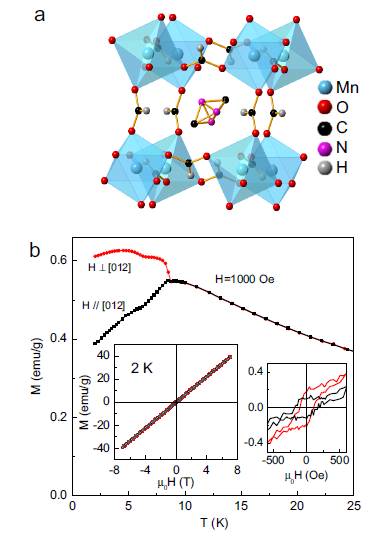《有機微納晶體和電子受體在有機光電器件中的研究》外文名《The study of organic micro nano crystal and electron acceptor in organic optoelectronic devices》。屬性為文章。屬有機光電器件領域。
基本介紹
- 中文名:有機微納晶體和電子受體在有機光電器件中的研究
- 外文名:The study of organic micro nano crystal and electron acceptor in organic optoelectronic devices.
- 屬性:文章
- 領域:有機光電器件
中文摘要,外文摘要,
中文摘要
本論文立足於有機半導體材料中精細構效關係的研究,著重提出了分子結構設計與合成、分子聚集體行為調控以及器件加工工藝最佳化、器件物理過程分析三步並重的研究思路。遵循此思路,發展了具有高遷移率的有機場效應電晶體材料和一系列具有高能量轉化效率的體異質結太陽能電池的電子受體材料。
在第一部分工作中,我們設計併合成了一類以苯並二噻吩為骨架的可溶性稠環分子,通過溶液加工方式將其加工為一維微納晶體,構建新型有機微納晶體電子學器件,獲得了空穴遷移率高達2.1㎝2 V-1 s-1的一維有機微納米場效應電晶體和光電放大率(Gain)高達1300微納米柔性紫外光檢測器。在最佳化器件加工工藝過程中,我們還發展了一種廉價高效加工不對稱電極接觸的一維微納米器件的工藝,並利用此工藝製備了輸出不對稱的電晶體器件和三態輸出的光控二極體器件。我們還系統研究了影響製備高遷移率電晶體器件和高效率光導器件的關鍵工藝變數,通過最佳化工藝步驟來調控有機半導體分子聚集體行為,詳細探究了具有推廣價值的有機電子學中材料結構與器件性能之間的構效關係。
在第二部分工作中,我們發展了一大類基於多取代苊並異吲哚二酮的分子。通過調整取代方式,製備了分子性質被精確控制的材料庫。我們利用該類材料代替富勒烯類衍生物作為電子受體與P3HT共混加工體異質結太陽能電池。通過材料篩選以及器件工藝最佳化,我們獲得了7個能量轉化效率超過2%的小分子電子受體材料,大大拓寬了非富勒烯衍生物小分子受體的材料庫。此外,我們還首次將倒裝電池結構引入到小分子受體材料的器件研究中,獲得了高達2.89%的能量轉化率,創下了以P3HT為給體時非富勒烯衍生物小分子受體最高的能量轉化率記錄。我們還利用該加工工藝製備了能量轉化率高達2.17%的全高分子太陽能電池。通過變數控制的方法對器件加工和性能測試中的各個變數進行了系統的控制和研究,我們找到了影響最終器件性能的關鍵變數,並通過化學結構修飾和工藝流程改進等手段調控關鍵變數進而最佳化器件性能。
總之,在研究一維有機微納米晶體在有機半導體器件中的套用和開發非富勒烯電子受體材料過程中,我們始終貫穿分子結構改變、分子聚集體行為調控和最終器件物理過程討論這條分為三段的研究主線,通過變數控制的思想尋找影響器件性能的關鍵變數,並通過化學修飾、工藝流程最佳化和器件物理分析等手段對關鍵變數進行強化,歸納精細的構效關係,以此為基礎更為理性高效率地發展更優更好的有機半導體材料。
在第一部分工作中,我們設計併合成了一類以苯並二噻吩為骨架的可溶性稠環分子,通過溶液加工方式將其加工為一維微納晶體,構建新型有機微納晶體電子學器件,獲得了空穴遷移率高達2.1㎝2 V-1 s-1的一維有機微納米場效應電晶體和光電放大率(Gain)高達1300微納米柔性紫外光檢測器。在最佳化器件加工工藝過程中,我們還發展了一種廉價高效加工不對稱電極接觸的一維微納米器件的工藝,並利用此工藝製備了輸出不對稱的電晶體器件和三態輸出的光控二極體器件。我們還系統研究了影響製備高遷移率電晶體器件和高效率光導器件的關鍵工藝變數,通過最佳化工藝步驟來調控有機半導體分子聚集體行為,詳細探究了具有推廣價值的有機電子學中材料結構與器件性能之間的構效關係。
在第二部分工作中,我們發展了一大類基於多取代苊並異吲哚二酮的分子。通過調整取代方式,製備了分子性質被精確控制的材料庫。我們利用該類材料代替富勒烯類衍生物作為電子受體與P3HT共混加工體異質結太陽能電池。通過材料篩選以及器件工藝最佳化,我們獲得了7個能量轉化效率超過2%的小分子電子受體材料,大大拓寬了非富勒烯衍生物小分子受體的材料庫。此外,我們還首次將倒裝電池結構引入到小分子受體材料的器件研究中,獲得了高達2.89%的能量轉化率,創下了以P3HT為給體時非富勒烯衍生物小分子受體最高的能量轉化率記錄。我們還利用該加工工藝製備了能量轉化率高達2.17%的全高分子太陽能電池。通過變數控制的方法對器件加工和性能測試中的各個變數進行了系統的控制和研究,我們找到了影響最終器件性能的關鍵變數,並通過化學結構修飾和工藝流程改進等手段調控關鍵變數進而最佳化器件性能。
總之,在研究一維有機微納米晶體在有機半導體器件中的套用和開發非富勒烯電子受體材料過程中,我們始終貫穿分子結構改變、分子聚集體行為調控和最終器件物理過程討論這條分為三段的研究主線,通過變數控制的思想尋找影響器件性能的關鍵變數,並通過化學修飾、工藝流程最佳化和器件物理分析等手段對關鍵變數進行強化,歸納精細的構效關係,以此為基礎更為理性高效率地發展更優更好的有機半導體材料。
外文摘要
The thesis focuses on the investigation of the structure-property relationship of organic semiconductors for optoelectronics. Molecular design and synthesis, modification of mesoscopic molecular assembly, and devices physics analysis were proposed to be three components of the sophisticated model to develop organic semiconductors with high performance. We developed an organic one-dimensional sub-micrometer single crystalline material for high performance transistors and photodetectors; and a series of novel non-fullerene organic electron acceptors for high performance bulk heterojunction (BHJ) photovoltaic cells.
First, a soluble benzodithiophene derivative was facilely developed to form one-dimensional (1D) sub-micrometer single crystal structures by solution process. A high performance transistor with hole mobility up to 2.1㎝2 V-1 s-1 and a high sensitive photodetector with gain up to 1300 were fabricated using such 1D structures as active materials. Through the optimization of the devices fabrication process, a new fabrication process with asymmetric electrodes contact was developed for an asymmetric transistor and a tri-state photodiode. The crucial variables for high performance devices based on 1D crystal structures were systematically investigated in detail.
Second, a series of acenaphtho[1,2-f]isoindole-8,10(9H)-dione derivatives were developed as the electron acceptors in the BHJ solar cells to replace fullerene derivatives. Through materials selection and process optimization, seven compounds with power conversion efficiency (PCE) up to 2% were obtained. Inverted solar cells with PCE as high as 2.89% were fabricated based on the o-CH3Ph-CN and P3HT blend films. To the best of our knowledge, it is the highest performance for BHJ solar cell based on non-fiillerene acceptors. Moreover, we also fabricated an all-polymer solar cell with PCE up to 2.17% via the same fabrication process. All the variables during molecular modification and devices fabrication were carefully controlled. The crucial variables were found, and were tuned to enhance the devices performance.
In conclusion, we developed a novel organic transistor material and electron acceptors via our tri-components research model. A sophisticated structure-property relationship was proposed and tested in both systems. Crucial variables were found via such control methodology, and were tuned by both chemical and physical modification. High performance materials and optimized fabrication process were achieved.
Keywords: One-Dimensional Organic Nanocrystal, Non-Fullerene Electron Acceptors, Organic Field Effect Transistors, Photodetector, Inverted Solar Cell.
Second, a series of acenaphtho[1,2-f]isoindole-8,10(9H)-dione derivatives were developed as the electron acceptors in the BHJ solar cells to replace fullerene derivatives. Through materials selection and process optimization, seven compounds with power conversion efficiency (PCE) up to 2% were obtained. Inverted solar cells with PCE as high as 2.89% were fabricated based on the o-CH3Ph-CN and P3HT blend films. To the best of our knowledge, it is the highest performance for BHJ solar cell based on non-fiillerene acceptors. Moreover, we also fabricated an all-polymer solar cell with PCE up to 2.17% via the same fabrication process. All the variables during molecular modification and devices fabrication were carefully controlled. The crucial variables were found, and were tuned to enhance the devices performance.
In conclusion, we developed a novel organic transistor material and electron acceptors via our tri-components research model. A sophisticated structure-property relationship was proposed and tested in both systems. Crucial variables were found via such control methodology, and were tuned by both chemical and physical modification. High performance materials and optimized fabrication process were achieved.
Keywords: One-Dimensional Organic Nanocrystal, Non-Fullerene Electron Acceptors, Organic Field Effect Transistors, Photodetector, Inverted Solar Cell.

